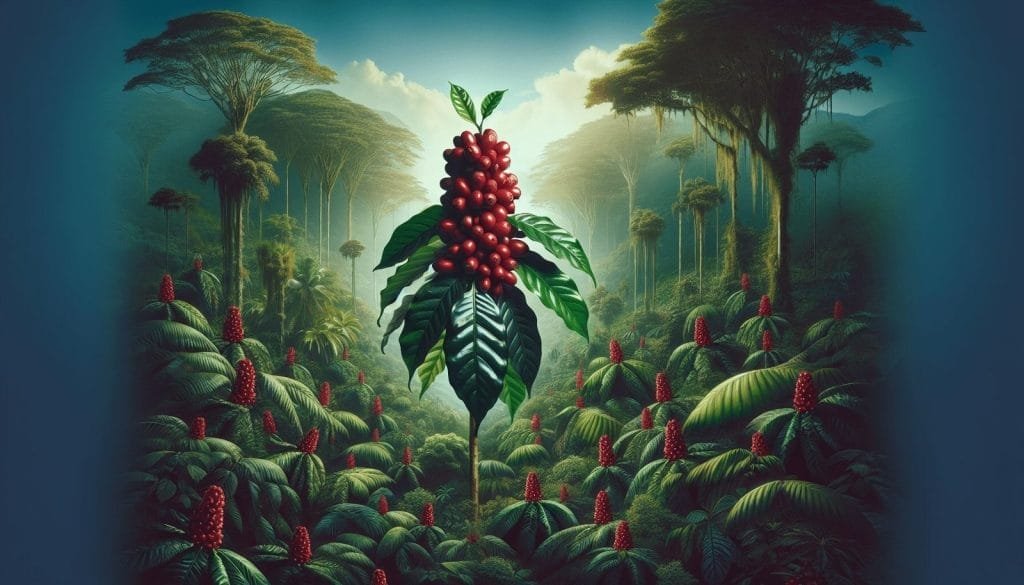Imagine a world without the tantalizing aroma of freshly brewed coffee, where the energizing elixir that kickstarts your day simply did not exist. It’s a hard concept to fathom, considering that coffee has become an integral part of our daily lives. But have you ever wondered where this magical bean, responsible for captivating our taste buds and fueling our productivity, originally came from? In this article, we will embark on a journey through time and geography to trace the roots of the coffee bean and discover the fascinating story behind its origins.

Timeline of Coffee Bean Origins
Discovered in Ethiopia
The story of coffee’s origins begins in Ethiopia, where it is believed to have been discovered in the 9th century. According to legend, a goat herder noticed that his goats became energetic after eating the cherries from a certain tree. Curious, he decided to try the cherries himself and experienced a similar boost in energy. Word of this magical fruit quickly spread, and coffee became a popular stimulant in Ethiopian culture.
Spread to the Arabian Peninsula
From Ethiopia, coffee made its way to the Arabian Peninsula. The Yemeni city of Mocha played a crucial role in the spread of coffee, as it became a major trading center for the beans in the 15th century. The Arabic word “qahwa,” meaning wine, was used to refer to these beans. Coffee houses began to appear in cities such as Cairo and Istanbul, becoming vibrant centers of social and intellectual discourse.
Introduced to Europe
Coffee’s journey to Europe can be traced back to the 16th century when it was discovered by European travelers. The first known coffeehouse in Europe was opened in Venice in 1645, and from there, the coffee culture quickly spread throughout the continent. Coffeehouses became important gathering places for intellectuals, artists, and politicians, fostering the exchange of ideas and shaping European society.
Colonization of the Americas
Coffee finally found its way to the Americas through colonization. The Dutch were the first to introduce coffee cultivation to their colony of Suriname in South America during the early 17th century. However, it was the French who played a significant role in establishing coffee plantations in the Caribbean, particularly on the islands of Martinique and Haiti. The labor-intensive nature of coffee production led to the use of enslaved Africans, creating a dark chapter in the history of coffee.
Coffee cultivation in Brazil
Brazil is now one of the world’s largest producers of coffee, but its coffee industry has relatively recent origins. Coffee cultivation was first introduced to Brazil in the early 18th century by Francisco de Melo Palheta, a Brazilian military officer, and it quickly became a vital component of the country’s economy. The tropical climate of Brazil, combined with vast expanses of land and a large population of available labor, created ideal conditions for coffee cultivation.
Coffee production in Africa
In the late 19th century, coffee production expanded in Africa, particularly in countries such as Ethiopia, Kenya, and Tanzania. These regions benefited from their favorable climate and altitude, which provided ideal growing conditions for high-quality Arabica coffee. African coffee is renowned for its vibrant flavors, often exhibiting fruity and floral notes that are cherished by coffee connoisseurs worldwide.
Expansion to Asia and Oceania
Coffee cultivation eventually made its way to Asia and Oceania. Countries such as India, Indonesia, and Papua New Guinea became significant players in the global coffee trade. India’s coffee industry grew rapidly in the 19th century under British colonial rule, and today, Indian coffee is known for its bold and earthy flavors. The volcanic soils of Indonesia, particularly in the regions of Sumatra and Java, produce unique and richly nuanced coffees. Australia also developed its coffee culture, with Melbourne becoming famous for its thriving coffee scene.
Modern coffee-growing regions
Today, coffee is grown in various regions around the world, with each location contributing its unique characteristics to the coffee bean. South and Central America, particularly Brazil, Colombia, and Costa Rica, are major producers of Arabica coffee, known for its smooth and balanced flavors. In Africa, Ethiopia, Kenya, and Rwanda continue to produce exceptional Arabica coffee. Asia, including countries like Vietnam and Thailand, has emerged as a significant producer of both Arabica and Robusta coffee.
Emerging markets for coffee cultivation
As global tastes and demands for specialty coffee continue to grow, new and unexpected regions are entering the coffee market. Countries such as Myanmar, Laos, and Nepal are starting to develop their coffee industries, offering new flavors and expanding the possibilities for coffee enthusiasts. These emerging markets not only add diversity to the coffee world but also provide economic opportunities for local farmers in these regions.
Environmental concerns in coffee production
As the demand for coffee continues to rise, so do the environmental concerns associated with its production. Deforestation, water pollution, and soil degradation are some of the issues that arise from conventional coffee farming practices. However, there is a growing movement towards sustainable coffee production that focuses on preserving biodiversity, protecting ecosystems, and supporting small-scale farmers. Initiatives such as shade-grown coffee, organic farming methods, and fair trade certifications are making positive impacts on the sustainability of the coffee industry.
Coffee Bean Varieties
Arabica
Arabica coffee, known scientifically as Coffea arabica, is the most widely consumed and highly prized coffee variety. It accounts for around 60% of global coffee production. Arabica beans are known for their complex flavors, ranging from fruity and floral to nutty and chocolatey. They generally have a lower caffeine content compared to Robusta beans and require specific growing conditions, including higher altitudes and cooler temperatures.
Robusta
Robusta coffee, or Coffea canephora, is the other major commercial coffee variety, accounting for approximately 40% of global coffee production. Robusta beans are known for their higher caffeine content and more robust flavors. They tend to have a stronger, more bitter taste and are commonly used in espresso blends to provide the desired crema and intensity. Robusta coffee plants are hardier and more disease-resistant than Arabica plants, allowing them to thrive in lower altitudes and warmer climates.
Liberica
Liberica coffee, also known as Coffea liberica, is a rare and exotic coffee variety. It originated in Liberia and has a distinctively large bean size compared to Arabica and Robusta. Liberica beans have a unique flavor profile, often described as smoky, woody, and with a hint of floral notes. This variety is less commonly cultivated and consumed compared to Arabica and Robusta but is still appreciated by coffee enthusiasts for its unique taste.
Excelsa
Excelsa coffee, scientifically known as Coffea excelsa, is often considered a subvariety of Liberica. It has a similar large bean size but is distinguished by its unique flavor characteristics. Excelsa coffee beans exhibit a tart and fruity flavor profile, with hints of dark fruits and a distinct acidity. Excelsa coffee is primarily grown in Southeast Asia and is frequently used in blends to enhance complexity and balance.
Other Varieties
In addition to the main coffee bean varieties mentioned above, there are various regional and heirloom varieties that contribute to the rich tapestry of coffee flavors. In certain parts of Ethiopia, for example, the heirloom coffee varieties have developed distinct flavor profiles that reflect their specific growing regions. Each of these other varieties possesses its unique combination of flavor, acidity, body, and aroma, adding to the diversity of the coffee world.
The Importance of Coffee in Different Cultures
Ethiopia
Ethiopia, considered the birthplace of coffee, has a deep cultural connection to this beloved beverage. Coffee ceremonies, known as “Buna,” are an integral part of Ethiopian social and cultural life. These ceremonies involve the careful roasting and brewing of the coffee beans, followed by the serving of the coffee in small cups. The Ethiopian coffee experience is characterized by a sense of community, with participants coming together to share stories and celebrate Ethiopian coffee traditions.
Yemen
Yemen has a long-standing tradition of cultivating and consuming coffee, with its coffee industry dating back centuries. Yemeni coffee, particularly the Mocha variety, is highly regarded for its unique and rich flavors. Coffee has played a vital role in Yemeni social and economic life, with coffeehouses serving as gathering places for discussions on politics, religion, and culture. The association of Yemen with coffee is so strong that the term “mocha” is still used today to refer to a specific type of coffee flavor.
Italy
Coffee is deeply ingrained in Italian culture, considered a daily ritual rather than a mere beverage. Italians take great pride in their coffee craftsmanship, with the art of espresso-making being meticulously honed over decades. Italian espresso, served in small cups with a rich crema on top, is known for its bold and intense flavor. Italian coffee culture also embraces the concept of the coffeehouse as a social hub, where people gather to engage in animated conversations and savor their espressos.
Brazil
For Brazilians, coffee is not just a drink but a symbol of their country’s identity and economic power. Brazil’s vast coffee plantations and production capabilities have made it the largest coffee exporter globally. Brazilian coffee, often characterized by its smooth and nutty flavor profile, is a staple in households and cafes across the country. Coffee plays a significant role in Brazilian social gatherings, offering a warm and welcoming gesture to visitors and friends.
Colombia
Colombia is renowned for producing high-quality Arabica coffee that is celebrated worldwide. Coffee cultivation in Colombia is deeply ingrained in the country’s history and cultural heritage. The National Coffee Park, located in the coffee-growing region of Quindio, offers visitors an immersive experience, allowing them to explore the coffee production process while learning about the cultural significance of coffee in Colombia. Coffee farming has played a crucial role in shaping Colombia’s economy and sustainable development.
Vietnam
Vietnam has earned itself a prominent position in the global coffee market through its robust coffee production. The country is the world’s second-largest coffee producer, largely focused on Robusta beans. Coffee plays a vital role in Vietnam’s daily life, with traditional Vietnamese coffee being prepared using a distinctive brewing method called “phin.” The result is a strong and dark brew that is often enjoyed with sweetened condensed milk. Vietnam’s coffee culture is a reflection of its vibrant street café scene and entrepreneurial spirit.
United States
Coffee has become an integral part of American culture, with numerous coffee shops and specialty cafes dotting the landscape. The United States is one of the world’s largest consumers of coffee, with a diverse range of preferences and tastes. From artisanal coffee roasters to third-wave coffee movements, the U.S. has embraced the craft and culture of coffee, with cities like Seattle and Portland becoming hotspots for coffee enthusiasts and barista competitions.
Japan
Japan has a unique and refined coffee culture that combines traditional tea rituals with the precision and attention to detail for which the country is known. Japanese coffee enthusiasts value exceptional quality and precision in brewing methods. Pour-over brewing techniques, such as the renowned “siphon” and “V60” methods, are favored for their ability to highlight the delicate flavors of specialty coffee. Coffee houses in Japan provide serene and tranquil spaces, enabling individuals to enjoy their cup of coffee in a calming environment.
Turkey
Turkey has a rich history and deep-rooted tradition when it comes to coffee. Turkish coffee is prepared in a unique way, where finely ground coffee beans are boiled with sugar and water, often resulting in a rich and thick texture. Coffee plays a significant role in Turkish hospitality, with guests often being served a cup of coffee as a gesture of warmth and friendship. In Turkey, coffeehouses have long been centers of socialization, where people gather to engage in card games, conversations, and storytelling.
Austria
Austria has a strong coffeehouse culture, with Vienna being particularly famous for its traditional coffeehouses. Viennese coffeehouses have a unique charm, offering a cozy and elegant ambiance where patrons can relax and savor their coffee. The Viennese have a particular affection for their strong black coffee, often accompanied by whipped cream or a slice of cake. Coffeehouses in Austria provide a haven for artists, intellectuals, and writers, fostering creativity and intellectual exchange.
Conclusion
The journey of the coffee bean spans centuries and continents, weaving a rich tapestry of flavors, cultures, and traditions. From its discovery in Ethiopia to its global spread and cultivation, coffee has had a profound impact on societies around the world. It has become a cherished part of daily life in many cultures, symbolizing hospitality, togetherness, and creative expression. As the coffee industry evolves and new regions emerge as key players, the diversity and complexity of the coffee bean continue to be celebrated and explored. Coffee remains a beloved beverage that connects people across time and borders, inviting us to savor not only its flavors but also the stories and experiences it represents.





